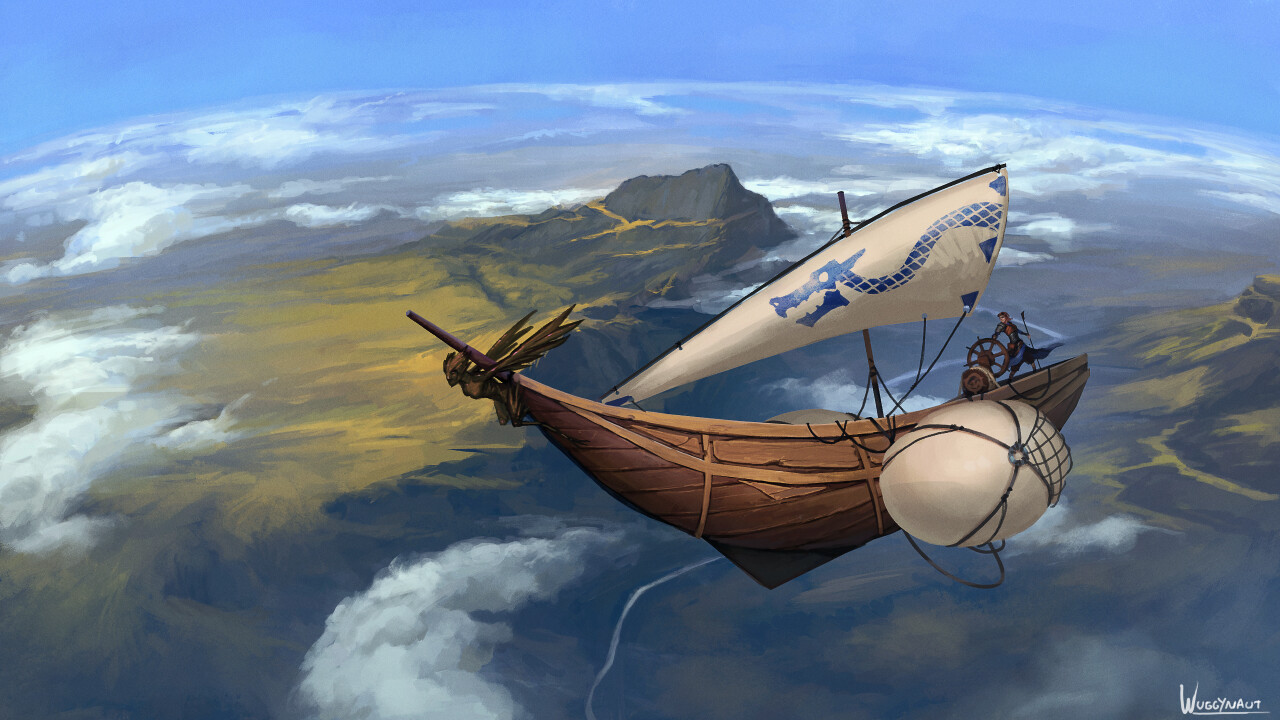Description
Skyships typically resemble ocean faring ships held aloft by three or more enchanted crystals. The enchanted crystals powering skyships' aerial suspension require charging for operation. The greater the charge, the higher the vessel can ascend. However, skyship crystals are constrained by a finite charging capacity, surpassing which triggers explosive consequences. This charge limit corresponds to an altitude threshold of approximately 1200 meters, effectively delineating a "second shore" for flying vessels. Consequently, skyships are impeded from surmounting towering mountain ranges or reaching airborne islands situated at greater elevations.
Remarkably, such limitations are nonexistent within the
Elemental Plane of Air. Here, the plane's inherent properties furnish the necessary lift, rendering altitude distinctions obsolete. Consequently, skyships navigating the Plane of Air are liberated from the constraints imposed by charged crystals, enjoying unrestricted mobility throughout the boundless expanse of the skies.
Some skyship have sails atop their deck in order to catch more wind for higher speeds, and often skyships also have some manner of sail protruding from the sides of the hull to act as wings and provide additional lift. Some skyships are seaworthy in case an emergency landing in the water is necessary.
Skyships typically require a crew of around six to ten to function, and can carry up to an additional thirty passengers. In addition, skyships can carry up to ten tons in cargo. Skyships are faster than ocean-bound ships, capable of flying at ten miles per hour. This expediency and the cost of construction and maintenance of the skyship makes them quite expensive, costing 100,000 gold to purchase outright, 2 gold per mile for each passenger, and 1 gold per 100 pounds of cargo per mile to ship.
Skyships fly at approximately the same height as birds can reach, or slightly higher for limited periods. The stronger winds at higher altitudes make maintaining course problematic, since the sails require gentler weather. For this reason, skyships try to avoid storms, and some have fallen or vanished in bad weather.
- Purchase Cost: 100,000 gp
- Speed: 10 mph
- Maximum Cargo: 10 tons
- Crew: 6–10
- Maximum Passenger Occupancy: 30
- Personal Travel Cost: 2 gp per mile per passenger
- Shipping Cost: 1 gp per 100 pounds per mile
Skyship route times
Travel by skyship from
Hillfar to
Atrechene, with little cargo, usually takes two or three days. A normal caravan would have taken one-and-a-half weeks.
With the potential construction of a skyship port in Iongual, an airship is expected to travel from Atrechene to
Ionguale in six to seven days, depending on the weather.
Vivenef
The
Vivenef ships are a unique and rare type of vessel that are built using a special material known as
Wizardwood, also known as
Dragon eggshell. This wood is incredibly durable and resilient, making it ideal for building ships that can withstand the harsh conditions of the open seas.
The awakened vivenef, with their inherent magical power are theorized to be able to be converted to flying ship.
History
The idea of skyships came to the brilliant mind of crafty
Gnome in the plane of air, wishing to fly like the native of the planes, the gnome sough a solution that could allow him and those he love to fly easily. Lacking the facilities to build such a massive contruct, the gnome turned to Hillfar and its industry, the first sjyships were built on the lightfootland in hillfar, with the creation and enchantment of
Magic crystals being a closely guarded secret of the
Lightfoot Kingdom.
While they sell skyships to foreign business, the lightfoot kingdom hold the monopoly on the creation and maintenance of their skyships. There are very few skyship ports (or skyports) in the world. By the year 1134 AD, skyship ports could be found in only two cities across all of Toriel: Hillfar and
Atrechene. A project of skyport construction in Ionguaule, a city within
Tana's Empire is heard of. Because of this, few skyships deviate from trade routes between these cities.






Comments